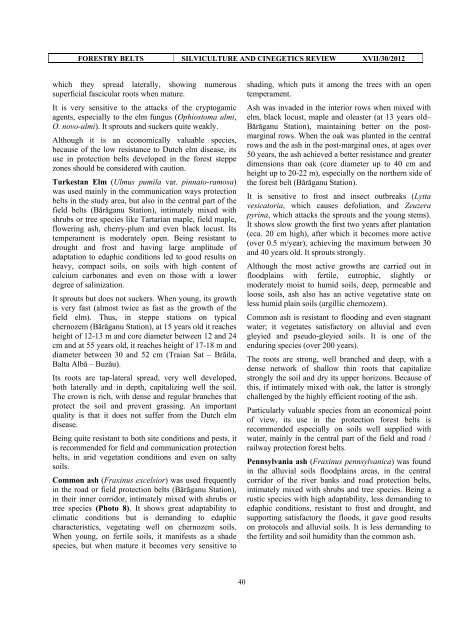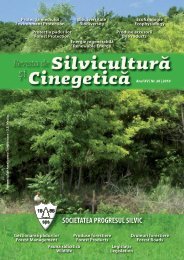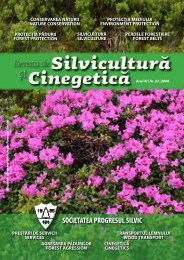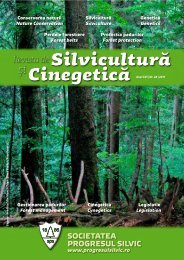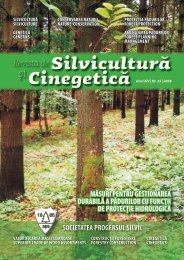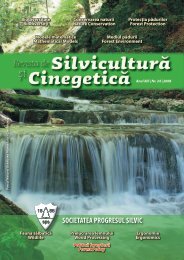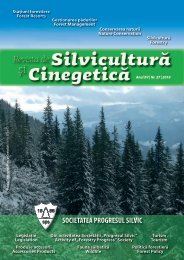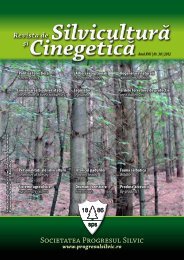Silviculture and Cinegetics Review - Societatea Progresul Silvic
Silviculture and Cinegetics Review - Societatea Progresul Silvic
Silviculture and Cinegetics Review - Societatea Progresul Silvic
Create successful ePaper yourself
Turn your PDF publications into a flip-book with our unique Google optimized e-Paper software.
FORESTRY BELTS SILVICULTURE AND CINEGETICS REVIEW XVII/30/2012<br />
which they spread laterally, showing numerous<br />
superficial fascicular roots when mature.<br />
It is very sensitive to the attacks of the cryptogamic<br />
agents, especially to the elm fungus (Ophiostoma ulmi,<br />
O. novo-ulmi). It sprouts <strong>and</strong> suckers quite weakly.<br />
Although it is an economically valuable species,<br />
because of the low resistance to Dutch elm disease, its<br />
use in protection belts developed in the forest steppe<br />
zones should be considered with caution.<br />
Turkestan Elm (Ulmus pumila var. pinnato-ramosa)<br />
was used mainly in the communication ways protection<br />
belts in the study area, but also in the central part of the<br />
field belts (Bărăganu Station), intimately mixed with<br />
shrubs or tree species like Tartarian maple, field maple,<br />
flowering ash, cherry-plum <strong>and</strong> even black locust. Its<br />
temperament is moderately open. Being resistant to<br />
drought <strong>and</strong> frost <strong>and</strong> having large amplitude of<br />
adaptation to edaphic conditions led to good results on<br />
heavy, compact soils, on soils with high content of<br />
calcium carbonates <strong>and</strong> even on those with a lower<br />
degree of salinization.<br />
It sprouts but does not suckers. When young, its growth<br />
is very fast (almost twice as fast as the growth of the<br />
field elm). Thus, in steppe stations on typical<br />
chernozem (Bărăganu Station), at 15 years old it reaches<br />
height of 12-13 m <strong>and</strong> core diameter between 12 <strong>and</strong> 24<br />
cm <strong>and</strong> at 55 years old, it reaches height of 17-18 m <strong>and</strong><br />
diameter between 30 <strong>and</strong> 52 cm (Traian Sat – Brăila,<br />
Balta Albă – Buzău).<br />
Its roots are tap-lateral spread, very well developed,<br />
both laterally <strong>and</strong> in depth, capitalizing well the soil.<br />
The crown is rich, with dense <strong>and</strong> regular branches that<br />
protect the soil <strong>and</strong> prevent grassing. An important<br />
quality is that it does not suffer from the Dutch elm<br />
disease.<br />
Being quite resistant to both site conditions <strong>and</strong> pests, it<br />
is recommended for field <strong>and</strong> communication protection<br />
belts, in arid vegetation conditions <strong>and</strong> even on salty<br />
soils.<br />
Common ash (Fraxinus excelsior) was used frequently<br />
in the road or field protection belts (Bărăganu Station),<br />
in their inner corridor, intimately mixed with shrubs or<br />
tree species (Photo 8). It shows great adaptability to<br />
climatic conditions but is dem<strong>and</strong>ing to edaphic<br />
characteristics, vegetating well on chernozem soils.<br />
When young, on fertile soils, it manifests as a shade<br />
species, but when mature it becomes very sensitive to<br />
shading, which puts it among the trees with an open<br />
temperament.<br />
Ash was invaded in the interior rows when mixed with<br />
elm, black locust, maple <strong>and</strong> oleaster (at 13 years old–<br />
Bărăganu Station), maintaining better on the postmarginal<br />
rows. When the oak was planted in the central<br />
rows <strong>and</strong> the ash in the post-marginal ones, at ages over<br />
50 years, the ash achieved a better resistance <strong>and</strong> greater<br />
dimensions than oak (core diameter up to 40 cm <strong>and</strong><br />
height up to 20-22 m), especially on the northern side of<br />
the forest belt (Bărăganu Station).<br />
It is sensitive to frost <strong>and</strong> insect outbreaks (Lytta<br />
vesicatoria, which causes defoliation, <strong>and</strong> Zeuzera<br />
pyrina, which attacks the sprouts <strong>and</strong> the young stems).<br />
It shows slow growth the first two years after plantation<br />
(cca. 20 cm high), after which it becomes more active<br />
(over 0.5 m/year), achieving the maximum between 30<br />
<strong>and</strong> 40 years old. It sprouts strongly.<br />
Although the most active growths are carried out in<br />
floodplains with fertile, eutrophic, slightly or<br />
moderately moist to humid soils, deep, permeable <strong>and</strong><br />
loose soils, ash also has an active vegetative state on<br />
less humid plain soils (argillic chernozem).<br />
Common ash is resistant to flooding <strong>and</strong> even stagnant<br />
water; it vegetates satisfactory on alluvial <strong>and</strong> even<br />
gleyied <strong>and</strong> pseudo-gleyied soils. It is one of the<br />
enduring species (over 200 years).<br />
The roots are strong, well branched <strong>and</strong> deep, with a<br />
dense network of shallow thin roots that capitalize<br />
strongly the soil <strong>and</strong> dry its upper horizons. Because of<br />
this, if intimately mixed with oak, the latter is strongly<br />
challenged by the highly efficient rooting of the ash.<br />
Particularly valuable species from an economical point<br />
of view, its use in the protection forest belts is<br />
recommended especially on soils well supplied with<br />
water, mainly in the central part of the field <strong>and</strong> road /<br />
railway protection forest belts.<br />
Pennsylvania ash (Fraxinus pennsylvanica) was found<br />
in the alluvial soils floodplains areas, in the central<br />
corridor of the river banks <strong>and</strong> road protection belts,<br />
intimately mixed with shrubs <strong>and</strong> tree species. Being a<br />
rustic species with high adaptability, less dem<strong>and</strong>ing to<br />
edaphic conditions, resistant to frost <strong>and</strong> drought, <strong>and</strong><br />
supporting satisfactory the floods, it gave good results<br />
on protocols <strong>and</strong> alluvial soils. It is less dem<strong>and</strong>ing to<br />
the fertility <strong>and</strong> soil humidity than the common ash.<br />
40


